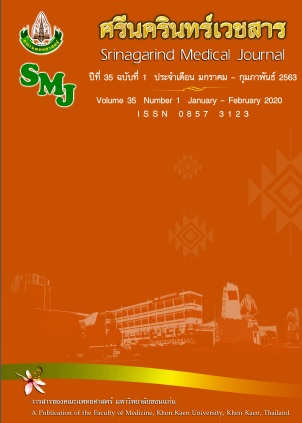Applying Augmented Reality for Anatomy Teaching and Learning
Keywords:
กายวิภาคศาสตร์, การเรียนการสอนกายวิภาค, AR, angmented reality, anatomyAbstract
การประยุกต์ใช้ Augmented Reality เพื่อการเรียนการสอนกายวิภาค
จิรัญดา กฤษเจริญ
หลักสูตรเวชนิทัศน์ คณะแพทยศาสตร์ มหาวิทยาลัยขอนแก่น
หลักการและวัตถุประสงค์: ปัจจุบันเทคโนโลยีการสื่อสารมีการพัฒนาอย่างต่อเนื่อง และมีความสลับซับซ้อนมากขึ้น McLuhan[i] กล่าวว่า The Medium is the message เป็นประโยคที่ชี้ให้เห็นว่าตัวสื่อ หรือช่องทางในการสื่อสารนั้นมีความสําคัญเป็นอย่างมาก เนื่องจากเพียง แค่เปลี่ยนตัวสื่อ แม้เนื้อหาจะเป็นเรื่องเดียวกัน แต่เนื้อหาก็ต้องเปลี่ยนแปลงไป การประยุกต์ใช้ Augment Reality (AR) เพื่อการเรียนการสอนกายวิภาค เป็นการวิจัยเพื่อ พัฒนางานประจำสู่งานวิจัยชิ้นหนึ่ง โดยมีคำถามนำวิจัยดังต่อไปนี้ 3 ข้อ ได้แก่1)ภาพ 3 มิตินั้นจะสามารถสร้างความน่าสนใจ ให้กับนักศึกษาได้หรือไม่ 2) การสร้างภาพ 3 มิติ เพื่อใช้กับ AR นั้นสามารถสร้างด้วยวิธีใดบ้าง และ 3) การสร้างภาพ 3 มิติ โดยมีเทคโนโลยี AR เป็นเครื่องมือนั้นจะสามารถทดแทน ตำรากายวิภาคได้หรือไม่ ทั้งนี้ผู้วิจัยได้เลือกประดิษฐ์ Application ที่นำเสนอ AR เฉพาะส่วน กะโหลก ศีรษะของมนุษย์ โดยให้มีลักษณะ interactive กับผู้ใช้ โดยทำงานบนระบบปฏิบัติการ Andriod โดย มีกระดูก 7 ชิ้นที่เป็นกระดูกบางส่วนของกะโหลกมนุษย์ ได้แก่ 1)Frontal Bone 2)Temporal Bone 3)Occipital Bone 4)Zygomatic Bone 5)Nasal Bone 6)Maxilla Bone 7) Mandible Bone
วิธีการศึกษา: ผู้วิจัยใช้วิธีการศึกษาแบบ Trial-Error ในการสร้างภาพสามมิติที่เป็นส่วนหนึ่งของ AR และทำการสัมภาษณ์กลุ่มเพื่อทดสอบประสิทธิภาพของสื่อ AR โดยมีกลุ่มตัวอย่างเป็น นักศึกษาแพทย์ 40 ราย ตั้งแต่ชั้นปีที่ 2-5 ชั้นปีละ 10 ราย และคณาจารย์ในภาควิชากายวิภาคศาสตร์ 5 ราย กลุ่มตัวอย่างแยก ตามชั้นปี ชั้นปีละ 10 ราย โดยทำการสุ่มเลือกจากรายชื่อนักศึกษา เพื่อนํามาสัมภาษณ์ เกี่ยวกับ ความน่าสนใจ ความรู้ และความเข้าใจในบทเรียนกายวิภาคที่ปรากฏในตําราที่มีการประยุกต์ใช้ AR เป็นตัวเสริม ทั้งนี้การเปิดรับ AR ที่เป็นภาพสามมิติ จะต้องใช้อุปกรณ์ที่มีกล้องถ่ายภาพ เช่น สมาร์ทโฟน หรือแท็บเล็ต จึงจะสามารถเปิดรับได้
ผลการศึกษา: พบว่าการสร้างภาพ 3 มิติ เพื่อใช้กับ AR ต้องใช้การปั้นแบบจำลองกะโหลก ด้วยโปรแกรมสำเร็จรูปมายา (Maya) กลุ่มตัวอย่างต้องการให้มีการหมุน รูปกะโหลกที่ปรากฏบนจอ Device ได้ 360 องศา และต้องการ ให้ย่อขยายผ่านทางหน้าจอซึ่งก็สามารถปรับ ให้มีการหมุนรูปกะโหลก 3 มิติได้ ส่วนการย่อ ขยายผ่านหน้าจอนั้น ยังมีความจำเป็นต้องพัฒนาต่อไป เนื่องจากต้องใช้ทรัพยากรของ เครื่องมาก นอกจากนี้ จากการสัมภาษณ์กลุ่มตัวอย่าง ยังให้ความเห็นว่า AR รูป กะโหลกนี้สามารถนำมาเป็น ส่วนเพิ่มเติมในตำรากายวิภาคทำให้ตำรามีความน่าสนใจ และเพิ่มมูลค่าให้หนังสือได้ในแง่ของการสร้าง ช่วยให้ผู้อ่านเห็น สัดส่วนความลึกของกะโหลก แทนที่จะเห็นเป็นเพียงภาพ 2 มิติ ที่มีลักษณะแบน เพียงอย่างเดียว แต่ไม่สามารถทดแทนตำราที่เป็นเล่มได้ เนื่องจากไม่สามารถใส่รายละเอียดได้
สรุป: เทคโนโลยี AR ไม่สามารถนำมาทดแทนตำราเรียนกายวิภาคศาสตร์ได้ แต่สามารถนำมาเพิ่มมูลค่า และ คุณค่าของตำราเรียนได้ นอกจากนี้ AR ยังช่วยให้ผู้รับสารสามารถมองเห็นสัดส่วนด้านความลึกของกะโหลก ซึ่งตำรากายวิภาคศาสตร์ที่ไม่มี AR ไม่สามารถทำได้
Background and Objective : At present, communication technology has continue developing complexly. McLuhan stated that “Medium is a Message”. This term remind us to aware that “channel” in communication process has more important, even message is the same but changing communication channel makes change to message. Receiving 3D image by AR have to use device with digital camera attached e.g. smart phone or tablet. Applying AR for teaching and studying Anatomy is a routine to research contains 3 research questions. Firstly, can 3D image gain very attention from audience? Secondly, How many method to create 3D image for AR? Thirdly, can 3D image, which use AR as a tool, replace Anatomy text book? In this research, researcher build Application which present 3D skull image. Seven bones, i.e. 1) Frontal Bone, 2) Temporal Bone, 3) Occipital Bone, 4) Zygomatic Bone, 5) Nasal Bone, 6) Maxilla Bone and 7) Mandible Bone, were choosen to present in this research. The application base on Android Operation System.
Method : Researcher used Trial-Error as a research method and used Focus Group interview to test effectiveness and gain opinion of samples which were 40 medical students, from second year students to interns medical students, also 5 Anatomy Lecturers were sampled by using simple random sampling from student and lecturer list. Questions were asked in Focus Group Interview were concerned interesting of AR Questions also about knowledge and understanding in Anatomy which appeared in Anatomy text book by using AR as the added on.
Result : The results showed that samples want the skull can be turned 360 degrees via touch screen of device. Moreover, sample want to zoom in and zoom out via touch screen. For turning skull via touch screen, researcher have collected this function as sample had recommended. On the other hand, zooming in and zooming out are too much consume technology resources of device. By the way, researcher aimed to develop this application and this function in future. Interviewing samples showed that AR skull can be added on in Anatomy text book which gain more attention and interesting from audience.
Conclusion : AR technology can’t replace Anatomy text book but, with AR, text book has more added value. Moreover, 3D image presented by AR technology, can provide wide perspective, high perspective and depth perspective, that ordinary 2D image in text book can’t present to readers.
References
McLuhan M, Understand Media : The Extensions of Man. 1st edition. London: MIT Press; 1964.
McQuail D. Mass Communication Theory: The Introduction. 5th edition. New York: Sage; 2005.
Wimmer RD, Dominick JR. Mass Media Research: An Introduction. 9th edition. London: Cengage; 2002.
จิราภรณ์ ปกรณ์ (2560). ฺAR (Augmented Reality) เทคโนโลยีโลกเสมือนผสานโลก แห่งความจริง. [ค้นเมื่อ 11 กันยายม 2562]. จาก https://www.scimath.org/article-technology/item/7755-ar-augmented-reality


